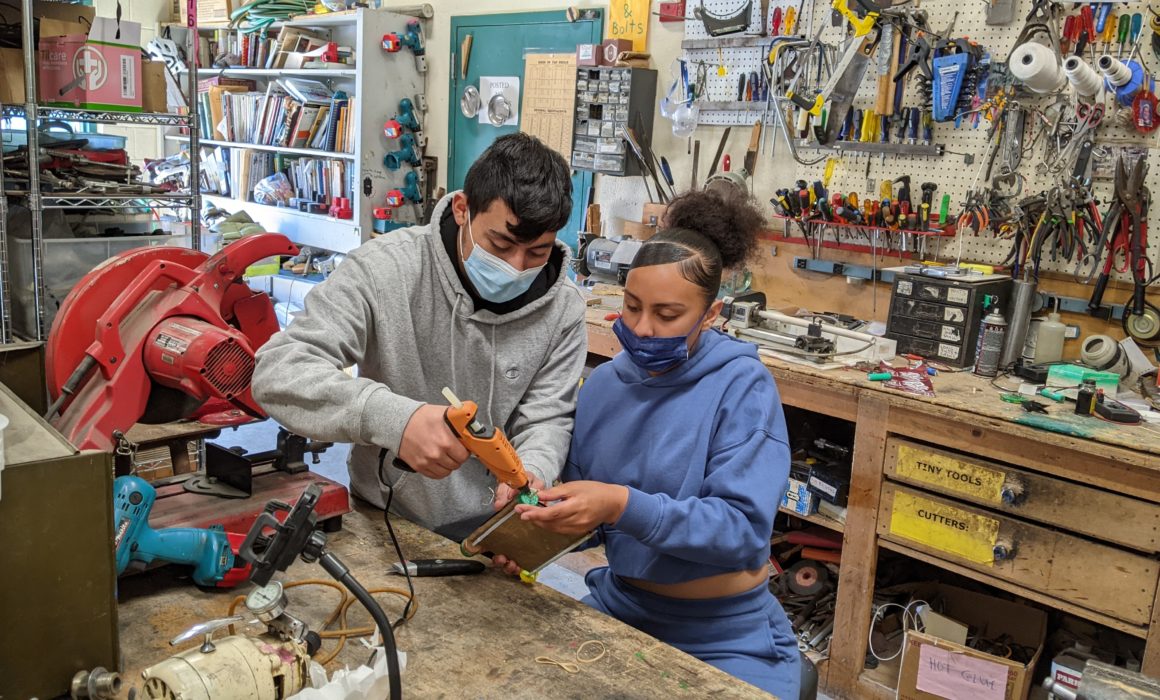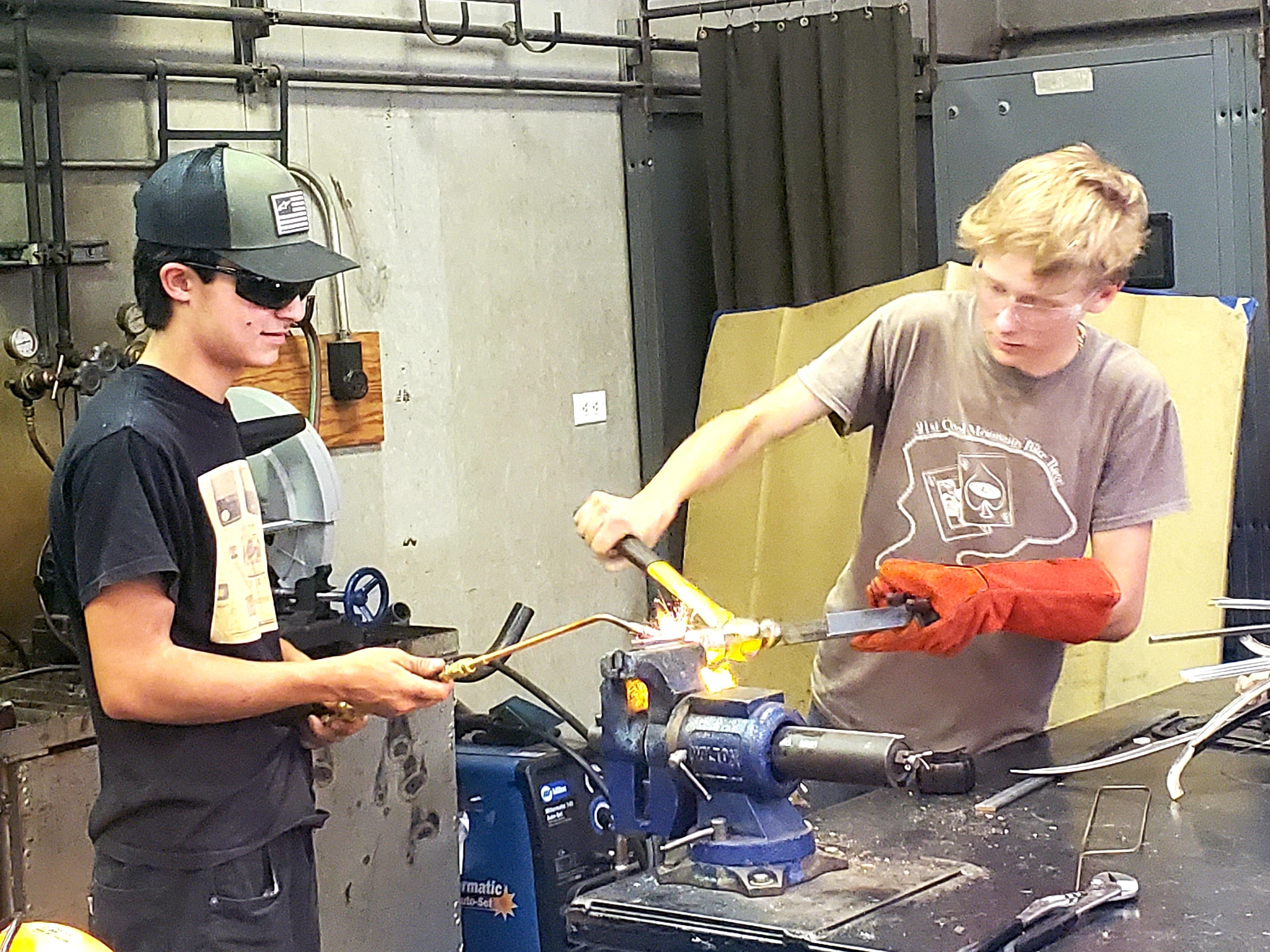
Solar, wind and hydroelectricity power are the focus at the Green Energy Academy at Edison High School in Fresno, a Career Technical Education program where students are mentored by experts and encouraged by educators to pursue careers in energy and the environment.
Through a partnership with PG&E, which donates money and materials, the academy offers a virtual internship. Students take a 10-hour OSHA certification course. The program, with its “school within a school” approach, serves as a model for other California Partnership Academies.
“Students gain the confidence here that will help them with work and college,” says John Berg, a Fresno Teachers Association member who teaches race and social justice classes at the academy. Students discover job opportunities they would never knew existed.
For example, students of Jamie Vargas, who teaches “introduction to electricity” and digital electronics, assist a private company with solar panel installations.
“I feel that the academy prepared me for the real world,” says Liz Agundez, a 2022 graduate who learned about energy conservation and reusable energy. She plans to attend CSU Fresno and become a civil engineer.

Green Energy Academy teachers, left to right: Jamie Vargas, John Berg and Kim Hau. The academy is a Career Technical Education program.
Welcome to the 21st century CTE.
When “vocational ed” was established decades ago, programs such as auto shop, wood shop, cosmetology and culinary arts were available, offering a pathway for non-college bound students to go straight into the workforce after high school. While many students made careers out of
what they learned, critics accused the system of tracking students from low-income families into the world of work instead of college.
 Today’s CTE is considered a pathway for students not only entering the workforce after graduation, but for those who plan on attending trade schools, two-year colleges for certificate programs and four-year universities. CTE is considered a stepping stone to higher education — and an avenue for students to hold jobs in their field while attending college.
Today’s CTE is considered a pathway for students not only entering the workforce after graduation, but for those who plan on attending trade schools, two-year colleges for certificate programs and four-year universities. CTE is considered a stepping stone to higher education — and an avenue for students to hold jobs in their field while attending college.
“There is a renewed interest in CTE and funding these vital programs has increasingly become a priority. CTE is slowly making a comeback. But the infrastructure needs serious repair after decades of cuts.”
— Lance Gunnersen, El Dorado Union High School Faculty Association
Previously there were 175 different designated subject credentials to teach vocational ed. As it gradually transitioned to CTE, credentials were streamlined into 15 designated subjects:
- Agriculture and natural resources
- Arts, media and entertainment
- Building and construction trades
- Business and finance
- Education, child development and family services
- Energy, environment and utilities
- Engineering and architecture
- Fashion and interior design
- Health, science and medical technology
- Hospitality, tourism and recreation
- Information and communication technologies
- Manufacturing and product design
- Marketing, sales and services
- Public services
- Transportation
To prepare for 21st century careers, secondary students at some school sites have the option to enroll in “pathways” or “academies” depending upon their interests.
- Charting CTE’s Course
- Windsor High School Vineyard Academy
- Animal Science Program
- NAF Business Academy
- AIMS Academy
In pathway programs and academies, core subjects are integrated with CTE curriculum. Most CTE courses meet A-G requirements for the CSU and the UC systems. Internships with local businesses are required. Some programs have dual enrollment with local colleges, so high school students receive college credits for classes. CTE also teaches soft skills like writing resumes, how to ace a job interview and responsibility.
Today’s CTE is indeed a long way from the “voc ed,” of yesterday, says Wendy Lockhart, CTA’s co-consultant to the Adult, Alterative and Career Technical Education Committee.
“Under traditional vocational education, the focus was on training a few students for a few jobs,” Lockhart says. “Today the goal is on training all students for careers, with multiple post-secondary options. Before, vocational ed was in lieu of regular studies. Now, in CTE programs, core subjects are embedded. In the past, vocational education was delivered part-time by ROP (Regional Occupation Program) teachers, off-site or after school. Now CTE is a program of study that involves a multi-year sequence of courses that integrates core academic knowledge with technical and occupational skills to provide students with a pathway to post-secondary education and careers.”
Does the new CTE meet all students’ needs?

Students in Edison High’s Green Energy Academy assist a private company with solar panel installations.
Some educators are concerned about the “shift” of CTE; worrying that pathways segueing to college have too much precedence over courses leading to blue-collar, well-paying jobs that do not require college. Some wryly refer to the “forgotten 70 percent” of students who do not graduate from college, and point out that students who attend or drop out of college accrue massive debt.
“There is a serious shortage of trained personnel in every single career in the trades, be it manufacturing, the auto industry, building trades, welding, carpentry and electricians,” says Lance Gunnersen, CTE committee chair for State Council. “These careers pay exceptionally well, and yet we have not created the workforce to fill the need, despite the fact that college is not a great fit for all teens.”
The California Industrial and Technology Education Association estimates that California’s middle schools and high schools have lost upwards of 85 percent of the original CTE delivery since the 1980s, says Gunnersen, a woodworking and engineering teacher at El Dorado High School in Placerville and a member of El Dorado Union High School Faculty Association. He attributes this to the elimination of categorical funding and districts choosing to focus on mostly A-G curriculum for entrance to four-year colleges. (This focus was no doubt influenced by data showing that in general, college graduates’ earnings over a lifetime are substantially more than non-college graduates.)
CTE programs in the skilled trades such as auto shop, wood shop, manufacturing and construction have suffered more cuts and closures than other CTE pathways such as health care, business and STEM academies, observes Mike Patterson, CTA Board member and automotive technology teacher at South Lake Tahoe High School.
“Cost is certainly a factor,” says Patterson. “And the attitude of ‘A-G for all’ has really been devastating, because many traditional CTE classes are not A-G, even though they offer strong employment skills and opportunities for students.”
“I hope there will be a revival of CTE based on the additional funding, but I still see many school districts not spending the funds on high-quality programs that prepare students for high-skills, highwage professions,” adds Patterson. “Programs were cut in my district and they are not coming back. We still have a long way to go toward meeting the needs of all students.”
Funding for “old” and “new” CTE
One place where traditional CTE has come back is Golden Sierra Junior Senior High School in Garden Valley, where Eric Harrelson reopened the automotive repair shop in 2020 that had been mothballed for five years.
 Harrelson had been hired in 2003 to teach shop and construction at Golden Sierra, the school he graduated from in the 1980s. But in 2015, a new superintendent dismantled CTE programs in the district. Harrelson and other instructors went from full teaching loads to being assigned one class per day. He returned to work in the private sector, and says it was devastating to see successful school programs cut to the bone despite an outpouring of community support.
Harrelson had been hired in 2003 to teach shop and construction at Golden Sierra, the school he graduated from in the 1980s. But in 2015, a new superintendent dismantled CTE programs in the district. Harrelson and other instructors went from full teaching loads to being assigned one class per day. He returned to work in the private sector, and says it was devastating to see successful school programs cut to the bone despite an outpouring of community support.
Since the newest superintendent brought back shop, automotive repair, welding and engineering courses, Harrelson now oversees a student-run auto shop where students provide services for El Dorado County residents such as repairing and rebuilding engines, brake jobs, wheel alignment and more.
“It’s exciting to see the pendulum starting to swing back for hands-on programs at my school,” says Harrelson, a Black Oak Mine Teachers Association member. “I love seeing students learning to be successful in the workplace and in life.”
Harrelson is among many educators feeling hopeful that support is growing for CTE programs. A big reason is new funding. In addition to state CTE incentive grants and Perkins funding (a federal act to improve CTE programs, integrate academic and career-technical instruction, serve special populations, and meet gender equity needs), the governor has proposed $1.5 billion for College and Career Pathways in the 2022-23 state budget.
If the budget is approved, funds will be spent over four years to start or expand pathways related to: technology (including computer science, green technology and engineering); health care; education (including early education); and climate-related fields for grades K-14, based on developing local partnerships that bring together school systems, higher education, employers and community stakeholders.
“Yes, there is a renewed interest in CTE and funding these vital programs has increasingly become a priority,” says Gunnersen. “I think CTE is slowly making a comeback. But the infrastructure needs serious repair after decades of cuts.”
CTE fosters success

Students in Eric Harrelson’s auto shop class at Golden Sierra Junior Senior High School in Garden Valley.
While state funding is on the horizon, and while everyone may not agree about which types of CTE best meet student needs, there is a growing consensus — and strong evidence — that CTE courses impact all students positively. According to the state Department of Education:
The average national graduation rate of students enrolled in CTE is 90 percent; other students, 75 percent.
CTE reduces behavioral problems and reduces dropout rates.
CTE attendance more than doubled the rate of college entrance for minority students and increased college enrollment rates for all student populations.
California Partnership Academy students beat state averages in passing the Exit Exam.
Equity needed for CTE teachers
Students may have more opportunities to participate in CTE — but CTE teachers are growing scarce. The shortage has had a huge impact on CTE programs. Gunnersen describes the teacher pool as “very limited” and continuing to decline.
“The lack of CTE teacher preparation programs at higher learning institutes for many of these career fields has been part of this problem. So has the fact that CTE teachers are often not recognized for the skills and talents they have. The inequity between CTE and academic teachers has also been a huge factor in keeping good instructors out of the classroom.”
Unlike multiple subject or single subject credentialed teachers, who must hold a college degree, CTE instructors are required to have a high school diploma and 3,000 hours of industry experience (and complete a CTE preparation program) to receive a CTE designated subject credential.
“They have years of relevant industry experience prior to teaching, yet face inequities in salary schedule placement and advancement,” says Lockhart. “Unfortunately, CTE credential holders are frequently placed on Step 1, Column 1 without ever making movement to Column 2 and beyond.”
The influx of federal, state and local funding toward developing and sustaining CTE pathways is creating an urgent need to develop methods for appropriate placement and movement of CTE credential holders on salary schedules, says Lockhart, who helped negotiate a more equitable pay scale for Beaumont Unified School District CTE teachers over a five-year period.
“CTA is working to help CTE teachers. By removing these inequities, we can entice experienced professionals from recognized industry sectors into the teaching profession and prepare our students to be successful in the future.”
CTE Terms to Know
California Partnership Academy(CPA): A three-year program, grades10-12, structured as a school-within a-school” where students focus on
career paths and explore their field of interest. By law, at least 50 percent of students in an academy must be considered at-risk. Academies create a close family-like atmosphere, integrating academics and CTE, and establish viable business partnerships. Currently, 340 programs are funded throughout California.
Lighthouse Academy: CPAs that have demonstrated that they meet or exceed the standards necessary for success and are models for other CPAs. CTE Pathways: Schools that offer a cluster of classes geared toward a specific industry or field.
Source: California Department of Education
The Discussion 0 comments Post a Comment